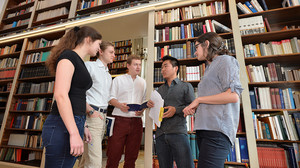The Maximilianeum Foundation
The building is owned by the Maximilianeum foundation. The Bavarian State Parliament is only the tenant.
When he was crown prince, Maximilian II of Bavaria (1811–1864) already drew up the plan to construct "a large national building at the high bank of the Isar near Munich" in order to "elevate the monarchical, national volksgeist". This was soon joined by the idea of an "athenaeum", an institute with the objective of "helping talented young Bavarian men (of any social status) to achieve the level of academic and intellectual education that is required in order to fulfil the higher responsibilities of state service". Unfortunately, Max II did not live to experience the completion of the institute building and the foundation did not even obtain legal form until his son and successor ludwig II was ruling.
According to the document of 1876, the Maximilianeum building as well as a gallery with historical paintings and marble busts belong to the foundation to this day. Following the end of the monarchy in 1918, the protectorate of the Maximilianeum Foundation was transferred to ludwig-Maximilians-Universität München. This has remained so to this day.
The Maximilianeum Foundation currently supports a total of 25 male secon dary school graduates. In addition, the "Wittelsbacher Jubiläums-Stiftung" foundation (established in 1980) is currently enabling 20 highly talented female secondary school graduates to obtain a scholarship. Since the institute was founded, approximately 800 students have been supported by the two foundations. Famous beneficiaries of the Maximilianeum Foundation have included Bavarian Minister-Presidents Eugen Ritter von Knilling (1865–1927) and Franz Josef Strauß (1915–1988) as well as Werner Heisenberg, winner of the nobel Prize in Physic s (1901–1976 ).

